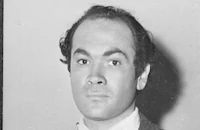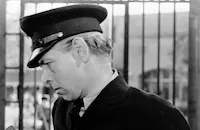Salome, Where She Danced
Cast & Crew
Charles Lamont
Yvonne Decarlo
Rod Cameron
David Bruce
Walter Slezak
Albert Dekker
Film Details
Technical Specs

Synopsis
On 9 April 1865, Jim Steed, a celebrated war correspondent, telegraphs his story, announcing the surrender of General Robert E. Lee and the end of the American Civil War, to his newspaper, Leslie's Weekly . Later, Jim travels to Berlin, where he is invited to a ball hosted by the Prussian leader, Count Otto Eduard Leopold von Bismarck. Jim quickly runs afoul of Bismarck's close advisor, Count Erik Von Bohlen, and tells Anna Maria, better known as Salome, the noted Austrian ballerina, that Von Bohlen is interested in her. Using that information, Salome agrees to entertain Von Bohlen in order to uncover Bismarck's plans for the anticipated Prussian invasion of Austria. On the first day of the Austrian-Prussian war, Jim witnesses the death of an Austrian prince who was romantically involved with Salome. Von Bohlen then arrives and threatens to have Jim executed for looting, but Jim informs him that he has found papers on the dead prince which prove that Von Bohlen divulged military secrets to Salome. Upon his release, Jim then helps Salome and her music teacher, Professor Max, escape from Berlin to America. After traveling cross-country for twenty-eight days, the three arrive in the western desert town of Drinkman's Wells, where they are taken in by Madame Europe, a hotel proprietor. In order to raise enough money to travel to San Francisco, they put on a show, and the beautiful Salome is an immediate hit with the local miners. Her performance is interrupted, however, by "Stagecoach" Cleve Blunt, an ex-Confederate soldier turned bandit, who steals the show's receipts. Despite a recent marital proposal by Jim, Salome is immediately attracted to and becomes involved with Cleve, as he is a double for her deceased Hapsburg prince. At Salome's urgings, Cleve returns all his stolen loot, and in gratitude, the townspeople rename Drinkman's Wells "Salome, Where She Danced." Salome, Jim and Max then travel to San Francisco, with Cleve and Madame Europe joining their theatrical troupe. Unable to find sponsorship for their show, Jim suggests that Salome become acquainted with Colonel Ivan Dimitrioff, a wealthy Russian diplomat. Cleve soon becomes jealous of Salome's involvement with Dimitrioff, who has gone so far as to give the ballerina a painting by Rembrandt. Upon the suggestion of his advisor, Dr. Ling, a Scottish-trained Chinese physician, Dimitrioff arranges a position for the newly pardoned Cleve with a stagecoach line, in hopes that distance will remove his romantic rival from Salome's heart. Instead, Cleve joins up with his old outlaw gang, only to be convinced once more into going straight by Ling and Salome. As a parting gift, Salome gives Cleve the locket with her picture inside that her Hapsburg prince once owned. On the night of her San Francisco opening, Von Bohlen arrives in town with a diplomatic warrant for Salome's arrest. Cleve comes to Salome's defense, however, and kills the Prussian count in a sword fight. Though she offers to return to Virginia with him, Cleve rejects Salome and announces his plans to return to his life as a highwayman. Despite Dimitrioff's threats, Salome refuses to dance that night and retires from the stage. With Jim and Ling's help, Cleve escapes with Salome aboard the Russian's private carriage. Though Dimitrioff is aware of their plot, he allows the couple to leave with his blessings.

Director
Charles Lamont
Cast

Yvonne Decarlo
Rod Cameron
David Bruce

Walter Slezak

Albert Dekker

Marjorie Rambeau

J. Edward Bromberg

Abner Biberman

John Litel
Kurt Katch

Arthur Hohl

Nestor Paiva
Gavin Muir

Will Wright
Joseph Haworth
Matt Mchugh

Poni Adams

Barbara Bates
Daun Kennedy
Kathleen O'malley

Karen Randle
Jean Trent
Kerry Vaughn
Jan Williams
Doreen Tryden
Bert Dole
Emmett Casey
Eddie Dunn
Charles Wagenheim
Gene Garrick
Eric Feldary
Sylvia Field
Richard Ryen
Colin Campbell
George Sherwood
Charles Mcavoy
Al Ferguson
Alan Edwards
George Leigh
Ina Ownbey
Eddie Cobb
Jack Clifford
Peter Seal
Bud Osborne
George Morrell
George Chesebro
Hank Bell
Jasper Palmer
Budd Buster
Dick Alexander
Cecilia Callejo
Jimmy Lang
Crew
Michael William Balfe
Bernard B. Brown
Alfred Bunn
Everett Carter
Edward Colman
Breezy Eason
Fred Frank
William Fritzsche
Victor A. Gangelin
Russell A. Gausman
Alexander Golitzen
Alexander Golitzen
John B. Goodman
W. Howard Greene
William Hedgcock
Lester Horton
Natalie Kalmus
Hal Mohr
Michael J. Phillips
Jack Pierce
Ronald K. Pierce
Len Powers
Russell Schoengarth
Laurence Stallings
Johann Strauss Ii
Ernest Truex
Walter Wanger
Edward Ward
Vera West

Film Details
Technical Specs

Quotes
Trivia
Notes
According to Hollywood Citizen-News in May 1944, Jean Moseman, a twenty-one-year-old secretary at Universal, was selected by producer Walter Wanger to play the lead in Salome, Where She Danced. In June 1944, however, Hollywood Reporter announced that Wanger was conducting a nationwide search for a new female star to play the lead. Photographers were asked to submit pictures of the most beautiful young women they had ever photographed, while dancing and singing schools, theaters, drama classes, magazines and newspapers were also invited to participate in the search. Hollywood Reporter later reported that Wanger was receiving approximately 500 letters a week in connection to this talent hunt. In August 1944, Wanger announced that he had selected eight finalists, including Mary Lou Campbell, Kerry Vaughn and Barbara Bates, all of whom were given screen tests for the role of "Salome." Yvonne De Carlo, however, was finally selected, having beaten out over 20,000 submissions. Vaughn and Bates were cast in small roles as "Salome girls." According to New York Times, De Carlo, formerly Peggy Yvonne Middleton of Vancouver, B.C., was under contract to RKO at the time.
According to information in the file on the film in the MPPA/PCA Collection at the AMPAS Library, the first submitted script for Salome, Where She Danced was rejected on August 31, 1944 on two main grounds: first, the character of "Stagecoach Cleve Blunt" was an outlaw who went unpunished for his illegal acts; and second, unacceptable references to the biblical story of Herod Antipas and Salome during a planned dance sequence were to be included. Universal submitted a revised script on September 14, 1944, which was passed by the PCA with minor objections.
Erle C. Kenton was originally set to direct Salome, Where She Danced, but he was replaced by Charles Lamont due to conflicting production schedules, according to Hollywood Reporter news items. An August 1944 Hollywood Reporter news item announced that Dean Harens had been cast as one of the male leads in the film, but he did not appear in the released film. Hollywood Reporter news items also state that locations were scouted in San Francisco, Monterey, Carmel and Santa Cruz, CA, but it has not been determined if any of these locals were actually used. According to New York Times, this film was shot at a cost of 1.2 million dollars. Hollywood Reporter news items include Paul Stanton and Harold Goodwin in the cast, but their appearance in the released film could not be confirmed.












